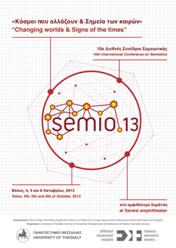The history of semiotics: Continuities, discontinuities and ruptures
Alexandros Ph. Lagopoulos
The object of the present paper is not a specific semiotic system, but the domain of semiotic theories in the strict sense – that is, excluding semiotising approaches, such as phenomenology or the British school of Cultural Studies; thus, my approach is meta-theoretical. Within this framework, the organising principle will be the opposition continuity vs discontinuity. On the basis of this opposition, a theoretical matrix will be constructed with the purpose to allow a deeper theoretical and historical understanding of the nature of the different semiotic currents and the relations between them.
The analysis follows five axes:
- The irreconcilable opposition between European Saussurean semiotics and North-American Peircian semiotics. Saussurean semiotics emerged from a scientific field, that of linguistics, while Peircian semiotics attempt to apply directly, and without mediations, a philosophy to a great variety of scientific fields. While Saussurean semiotics limits itself to the domain of culture, Peircian semiotics has the ambition to claim also a part of the positive sciences, namely life sciences, starting with zoosemiotics and ending with biosemiotics.
- The continuous development of Saussurean semiotics. For about seven decades, Saussurean ‘classical’, ‘orthodox’ semiotics has evolved through a series of currents. These currents brought a continuous widening, deepening and refinement of the semiotic concepts and classical semiotics had a profound impact on social sciences, the humanities and the arts.
- The relation between structuralism and poststructuralism. From the ideological (and rather messianic) viewpoint of poststructuralism, this relation is one of rupture, but from the metatheoretical viewpoint there is a strong thread of continuity (including Lévi-Straussian views), without denying the factor(s) of discontinuity due to German philosophy and the factors discussed below (e).
- The influence of Marxism on classical semiotics. It is a notable fact that the majority of classical semioticians, due to the positivist and formalist nature of semiotics, are ignorant of, not to say inimical to, Marxism. This is why I feel it important to make reference to the influence of Marxism on semiotics.
- The influence of Marxism on poststructuralism. Poststructuralism started emerging just a few years before May ’68, but this uprising had a decisive impact on its formation. The active forces in the streets of Paris were, on the one hand, the Situationists and the Surrealists, and on the other the psychoanalysts, who proved to be a kindred movement. Most of the leading poststructuralist figures were affiliated to the official or radical Left.
- The relation between poststructuralism and postmodernism. Postmodernism as a theory followed poststructuralism, both in the historical and the theoretical sense, but as a concrete phenomenon it predates it, since it first appeared as an artistic reaction against high modernism in the U.S. of the sixties. Theoretical postmodernism emerged from the encounter of French poststructuralism with this local American postmodernism. The merging of the two traditions inescapably led to misunderstandings.
The paper will close with a typological matrix, displaying the classification of the semiotic currents in respect to the theoretical matrix above, some brief thoughts about the diffusion of the main semiotic currents and a proposal for what I believe to be a fertile future orientation for semiotics.



